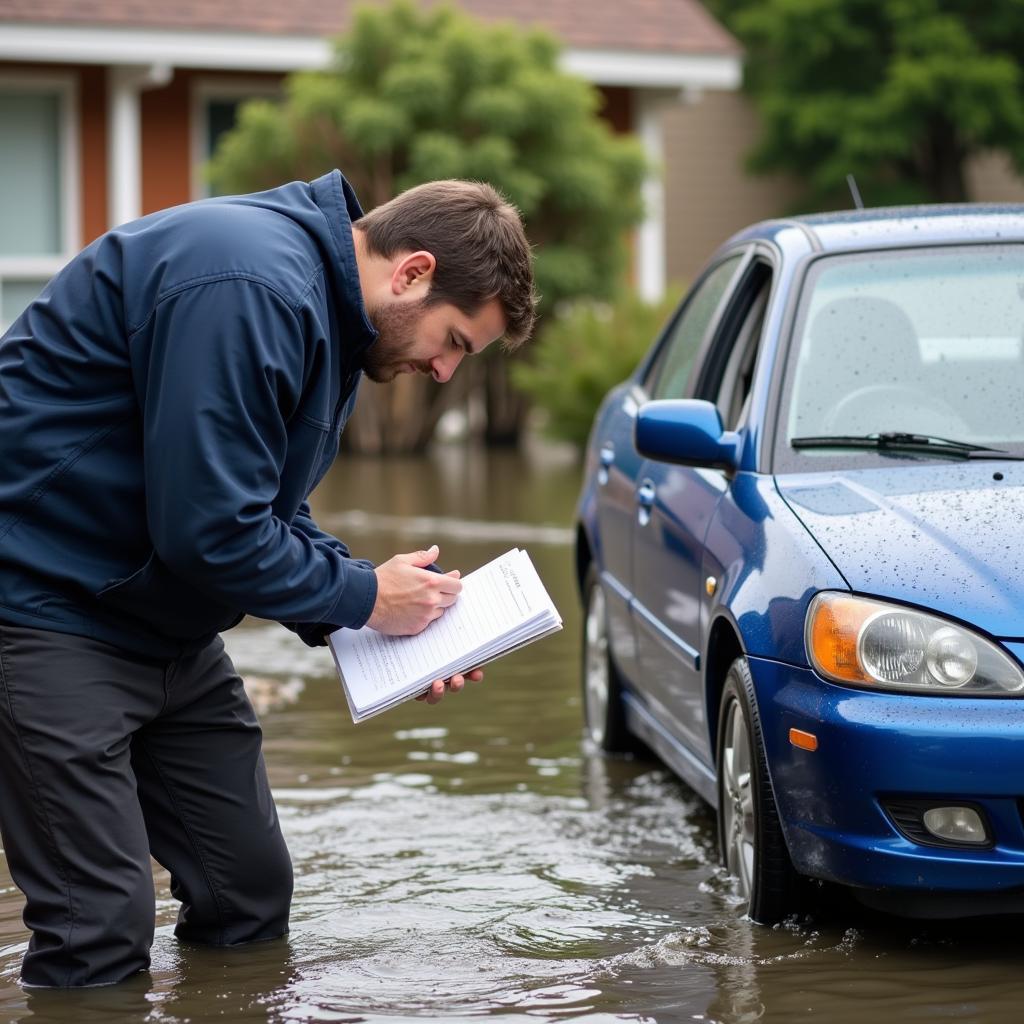Waking up to a flooded car can be a nightmare. And the first question that likely pops into your head is, “How Much Will It Cost To Fix A Flooded Car?” Unfortunately, there’s no easy answer. The cost can range from a few hundred dollars for minor cleanup to a complete write-off, depending on the extent of the damage. This article will guide you through the factors influencing repair costs, helping you make informed decisions about your flooded vehicle.
After a flood, your car might look okay on the outside, but the real damage often lies beneath the surface. Water can wreak havoc on electrical systems, engines, transmissions, and interiors. Determining the true cost requires a thorough inspection by a qualified mechanic. Even seemingly minor flooding can lead to significant problems down the road.
Understanding the Damage: Key Factors Affecting Repair Costs
Several factors contribute to the final bill when fixing a flooded car. The depth of the water is critical. A few inches of water might only affect the carpets and upholstery, while water reaching the dashboard can damage vital electronic components. The type of water also matters. Clean rainwater is less damaging than contaminated floodwater, which carries mud, debris, and sewage, potentially corroding metal parts and creating long-term issues. The duration of submersion also plays a significant role. The longer the car sits in water, the more extensive the damage.
 Flooded Car Engine Damage
Flooded Car Engine Damage
The car’s make and model also influence repair costs. Luxury vehicles with complex electronic systems tend to be more expensive to repair than older, simpler models. Finally, the availability of replacement parts can affect both the cost and repair time.
Assessing the Damage: A Step-by-Step Guide
Before getting an estimate, you can perform a preliminary assessment to understand the extent of the damage. First, check the waterline. If the water reached the dashboard or higher, the damage is likely extensive. Next, inspect the interior for watermarks, mold, and mildew. Look under the carpets and seats for signs of water damage. Then, check the engine compartment for water, mud, and debris. Finally, try starting the car. Do not attempt to start the car if the water reached the dashboard or engine, as this can cause further damage.
Is It Worth Fixing? The Economics of Flood Repair
Once you have a clear picture of the damage, you need to decide whether it’s financially viable to repair the car. If the repair cost exceeds the car’s value, it’s usually best to declare it a total loss. Your insurance company will play a crucial role in this decision. Fixing an old car after driving through water can be a costly affair.
Working with Insurance: Navigating the Claims Process
If you have comprehensive coverage, your insurance policy should cover flood damage. Contact your insurance company immediately to file a claim. They will send an adjuster to assess the damage and determine the payout. Be sure to document the damage with photos and videos. Keep all receipts for repairs and related expenses.
 Insurance Adjuster Inspecting Flooded Car
Insurance Adjuster Inspecting Flooded Car
Preventing Future Flood Damage: Proactive Measures
While you can’t always predict floods, you can take steps to minimize the risk. Avoid parking in low-lying areas, especially during heavy rain. If a flood is imminent, move your car to higher ground if possible. Consider investing in flood barriers or sandbags to protect your property.
“Regular maintenance and inspections are vital,” says John Miller, a certified automotive technician with over 20 years of experience. “This allows you to catch and address potential issues early on, preventing small problems from becoming major, costly repairs, especially in situations like flood damage.”
Tips for Maintaining Your Car After a Flood
If your car has been through a flood, even a minor one, proper maintenance is essential to prevent long-term problems. Thoroughly clean and dry the interior to prevent mold and mildew growth. Have a mechanic inspect the electrical system, engine, and transmission for damage. Change all fluids, including engine oil, transmission fluid, and coolant. Finally, lubricate all moving parts to prevent corrosion.
“Don’t underestimate the hidden damage,” advises Susan Davis, a mechanical engineer specializing in vehicle diagnostics. “Water can penetrate seemingly sealed areas and cause corrosion over time. A thorough professional inspection is crucial after any flood exposure.”
Conclusion: Making Informed Decisions After a Flood
Knowing how much it will cost to fix a flooded car requires careful assessment and professional guidance. By understanding the factors influencing repair costs and taking proactive steps, you can make informed decisions about your flooded vehicle and protect your investment. If you need further assistance or expert advice, don’t hesitate to contact AutoTipPro at +1 (641) 206-8880. Our office is located at 500 N St Mary’s St, San Antonio, TX 78205, United States. We’re here to help you navigate the challenges of flood damage repair.
Fixing an old car after driving through water can be a complex undertaking. Therefore, it is important to contact a professional.




Leave a Reply